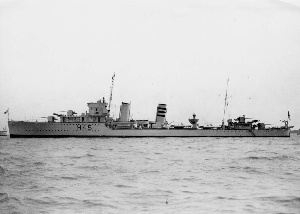HMS Acheron (H45) facts for kids

HMS Acheron
|
|
Quick facts for kids History |
|
|---|---|
| Name | HMS Acheron |
| Namesake | Acheron, a river in Greek mythology |
| Ordered | 29 May 1928 |
| Builder | John I. Thornycroft & Company, Woolston, Hampshire |
| Laid down | 29 October 1928 |
| Launched | 18 March 1930 |
| Commissioned | 13 October 1931 |
| Motto | "Post tenebras lux" (After darkness light) |
| Fate | Sunk, 17 December 1940 after hitting a mine |
| Badge | On a Field Black, barry wavy of 4 Silver. |
| General characteristics (as built) | |
| Class and type | A-class destroyer |
| Displacement | |
| Length | 323 ft (98 m) (o/a) |
| Beam | 32 ft 3 in (9.83 m) |
| Draught | 12 ft 3 in (3.73 m) |
| Installed power |
|
| Propulsion | 2 × shafts; 2 × geared steam turbines |
| Speed | 35 knots (65 km/h; 40 mph) |
| Range | 4,800 nmi (8,900 km; 5,500 mi) at 15 knots (28 km/h; 17 mph) |
| Complement | 134; 140 (1940) |
| Armament |
|
HMS Acheron was a special type of warship called an A-class destroyer built for the Royal Navy. She was a fast and powerful ship designed to protect larger ships and attack enemy vessels. Acheron served during World War II near Britain and off the coast of Norway. Sadly, she was lost early in the war. On December 17, 1940, she hit a mine near the Isle of Wight and sank. Today, the place where her wreck lies is protected by law.
Contents
Building and Joining the Fleet
The order to build Acheron was placed on May 29, 1928. She was constructed by John I. Thornycroft & Company in Woolston, Hampshire. The ship's construction began on October 29, 1928. She was then launched into the water on March 18, 1930. Finally, Acheron officially joined the Royal Navy on October 13, 1931.
From the very beginning, Acheron had some mechanical issues. These problems continued throughout her time in service. When World War II started in September 1939, she was being repaired in Portsmouth. She couldn't join the war effort until December 1939.
Wartime Missions and Duties
After her repairs were finished, Acheron joined the 16th Destroyer Flotilla. This group of ships was part of the Home Fleet based at Scapa Flow. Her main jobs were to protect convoys of ships and screen larger fleet vessels. These duties took place in the North Sea and the waters around Britain.
Supporting the Norway Campaign
When Germany invaded Norway on April 9, 1940, Acheron was sent to help. She supported British troops landing in Norway. On April 17, she helped escort several cruisers, including Galatea and Arethusa. These cruisers were carrying soldiers to Åndalsnes and Molde.
Once they arrived at Åndalsnes on April 18, Acheron was given patrol and escort tasks. She also escorted the aircraft carrier Glorious from Scapa Flow. Later, she worked with other destroyers like Antelope and Beagle off Namsos.
Evacuating Troops and Damage
On May 31, Acheron joined other destroyers to escort the carriers Glorious and Ark Royal. Their mission was to cover the final evacuation of British troops from Norway. This important operation, called Operation Alphabet, finished by June 9. After this, Acheron went back to her usual duties.
She then moved to the English Channel to protect convoys. On June 21, she was in dock at Portsmouth to get a new gun. This new 3-inch High Angle gun was added to improve her defense against enemy aircraft. While sailing off St Catherine's Point on July 20, German dive bombers attacked her. She was damaged by nine bombs that exploded very close to her.
Repairs and Air Raid Damage
Acheron began repairs at Portsmouth Dockyard on August 6. However, on August 24, she was badly damaged during an air raid. One bomb hit her back section and exploded. This caused serious damage to her engines and a main gun. Two of her crew members were killed, and three others were injured.
Because of this damage, her repairs took longer, lasting until October. Her damaged gun was replaced with one from another destroyer, Boadicea. In November, Acheron was chosen to become a gunnery training ship.
The Sinking of HMS Acheron
Repairs were fully completed by December 2, 1940. Acheron then began her post-repair tests at sea. On December 17, she was sailing off the Isle of Wight. The tests were happening at night, in rough seas, and with a strong wind. It was completely dark.
She was performing speed tests over a measured mile, about 8 nmi west-south-west of St. Catherine's Point. During one of these passes, she hit a mine. The explosion caused huge damage to the front of the ship. Her own speed pushed her deeper into the water.
Acheron sank in just four minutes. A total of 196 people, including crew members and shipyard workers, went down with the ship. Only 19 people survived. The mine was likely one of those laid by the German Luftwaffe along the Channel coast. The sinking of Acheron was not announced to the public until December 27, 1940.
Today, the wreck site of Acheron is a Protected Place. This means it is legally protected under the Protection of Military Remains Act 1986.
Images for kids


